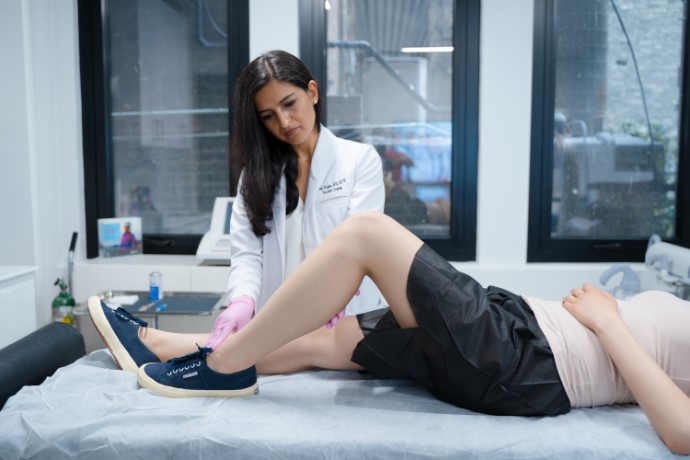When Should You See a Vascular Doctor?

Vascular health plays a critical role in your overall well-being, yet many people tend to overlook it until problems arise. From varicose veins to more severe conditions like deep vein thrombosis (DVT), understanding when to seek specialized care is vital. A When to see a Vascular Doctor, or vascular specialist, is trained to diagnose and treat diseases related to your blood vessels, arteries, and veins. But how do you know when it’s time to consult one?
This guide will help you understand the signs and symptoms that signal it’s time to see a vascular doctor. We will explore common vascular conditions, who is most at risk, and the benefits of early intervention.
What Are Common Vascular Conditions?
Vascular conditions range from cosmetic concerns, such as spider veins, to more serious, potentially life-threatening issues. Here are a few of the most common vascular disorders:
- Varicose Veins: These twisted, enlarged veins can appear on the legs and are often caused by poor circulation. While they are generally harmless, they can lead to discomfort, swelling, and in some cases, more severe complications.
- Deep Vein Thrombosis (DVT): DVT occurs when a blood clot forms in one of the deep veins, usually in the legs. It can cause pain, swelling, and if untreated, can lead to pulmonary embolism—a life-threatening condition.
- Peripheral Artery Disease (PAD): PAD results from narrowed arteries, which reduce blood flow to the limbs. It often leads to leg pain, especially when walking.
- Aneurysms: These are bulges in the wall of a blood vessel, and if they rupture, they can cause severe internal bleeding.
- Carotid Artery Disease: This condition occurs when the arteries in the neck, which supply blood to the brain, become narrowed or blocked, increasing the risk of stroke.
What Are the Symptoms That Require a Vascular Doctor?
Recognizing the symptoms of vascular disease early can significantly improve treatment outcomes. Below are common signs that indicate you should see a vascular doctor:
- Swollen or Painful Legs: Swelling in the legs, particularly around the calves or ankles, can be a symptom of poor circulation or venous insufficiency. If your legs feel heavy, achy, or you notice frequent cramping, it might be time to consult a vascular specialist.
- Non-Healing Wounds: Ulcers or sores, especially on the feet or lower legs, that don’t heal properly may indicate peripheral artery disease (PAD). Poor circulation prevents the tissues from receiving enough oxygen and nutrients to heal.
- Numbness or Tingling: Reduced blood flow to the limbs can lead to sensations of numbness or tingling, especially in your feet and toes. This can also be a sign of PAD or other circulatory issues.
- Visible Veins: Varicose or spider veins are often visible on the surface of the skin. While these might seem like minor cosmetic issues, they can indicate deeper circulatory problems that require medical attention.
- Chest Pain or Shortness of Breath: If you experience chest pain or difficulty breathing, it could be a sign of a blood clot in your lungs (pulmonary embolism). In this case, immediate medical attention is necessary.
- Sudden, Severe Headaches: A sudden, intense headache could indicate a ruptured aneurysm, especially if it’s accompanied by vision changes or neck pain. A vascular doctor can assess your risk and recommend the necessary tests.
Who Is at Risk for Vascular Disease?
While anyone can develop vascular issues, certain factors increase your risk. Understanding these risk factors can help you stay proactive about your vascular health.
- Age: As you age, your blood vessels lose elasticity, and your risk for conditions like varicose veins, PAD, and aneurysms increases.
- Family History: A family history of vascular disease, high blood pressure, or high cholesterol increases your chances of developing similar problems.
- Smoking: Smoking damages your blood vessels and accelerates the hardening of arteries, making smokers more susceptible to PAD and aneurysms.
- Obesity: Excess weight puts added pressure on your veins, leading to problems such as varicose veins and DVT. It also increases your risk of high blood pressure and diabetes, both of which are linked to vascular disease.
- Diabetes: High blood sugar levels damage blood vessels over time, leading to conditions such as PAD, which can result in amputations if left untreated.
- Sedentary Lifestyle: Lack of physical activity can contribute to poor circulation, obesity, and the formation of blood clots, all of which increase your risk for vascular issues.
What Are the Benefits of Early Diagnosis and Treatment?
Early diagnosis and treatment of vascular conditions can prevent serious complications and improve your quality of life. Seeing a vascular doctor at the first sign of trouble offers several key benefits:
- Preventing Complications: Early intervention can prevent minor issues from developing into severe, life-threatening conditions. For example, treating varicose veins early can prevent ulcers, and identifying DVT early can prevent pulmonary embolism.
- Improving Mobility: Conditions like PAD or varicose veins can cause pain and discomfort, limiting your ability to walk or engage in physical activity. Proper treatment can relieve these symptoms and help you regain mobility.
- Lowering Stroke Risk: Carotid artery disease can lead to a stroke if left untreated. A vascular doctor can assess your risk and recommend treatments, such as medications or surgery, to reduce your chances of having a stroke.
- Reducing the Need for Surgery: Treating vascular conditions early can often be done with less invasive procedures. For example, varicose veins can be treated with laser therapy, whereas more advanced cases might require surgery.
What Treatments Are Available for Vascular Disease?
A vascular doctor can offer a variety of treatment options depending on the specific condition. Here are some common treatments:
- Medications: Blood thinners, cholesterol-lowering drugs, and medications to improve blood flow are often prescribed for vascular conditions like PAD or DVT.
- Minimally Invasive Procedures: Many vascular conditions can be treated with minimally invasive procedures. For example, varicose veins can be treated with laser therapy, sclerotherapy, or radiofrequency ablation.
- Surgery: In severe cases, surgery might be necessary. Procedures like angioplasty or bypass surgery are common for treating PAD, while aneurysms may require surgical repair to prevent rupture.
- Compression Therapy: For conditions like varicose veins or chronic venous insufficiency, compression stockings can help improve blood flow and reduce swelling.
When Should You Schedule an Appointment with a Vascular Doctor?
If you experience any of the symptoms mentioned, it’s crucial to schedule an appointment with a vascular doctor sooner rather than later. Delaying treatment can lead to more serious complications, including blood clots, stroke, and even limb loss. Regular check-ups with a vascular specialist are especially important if you have risk factors such as diabetes, high blood pressure, or a family history of vascular disease.
Early diagnosis and treatment not only improve your health but also enhance your quality of life. Don’t wait for symptoms to worsen—be proactive about your vascular health.
In conclusion, seeing a vascular doctor when you notice early signs of vascular disease can help you avoid complications and maintain good circulation. From varicose veins to more severe conditions like DVT, knowing when to seek expert care is the key to preventing long-term issues.




